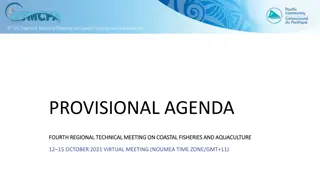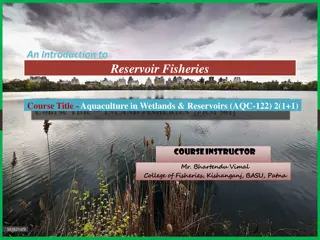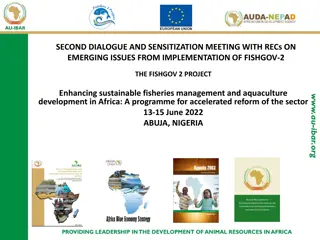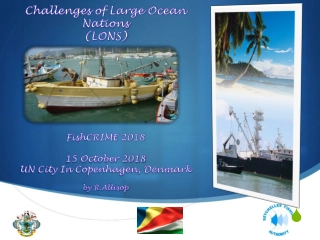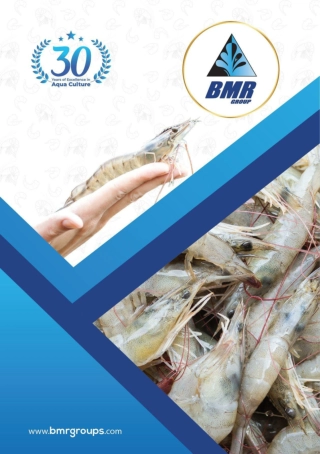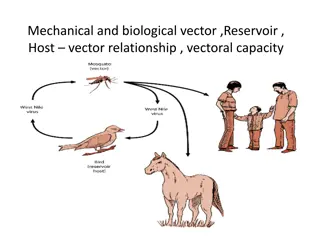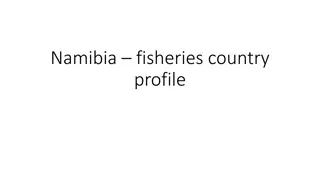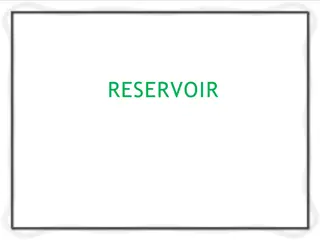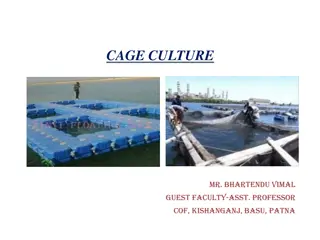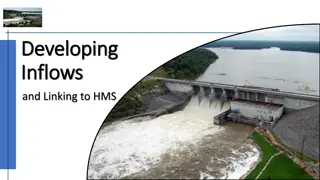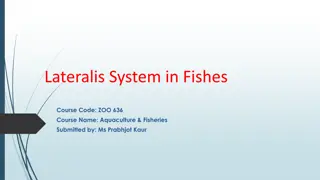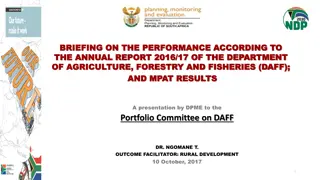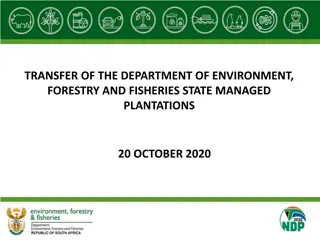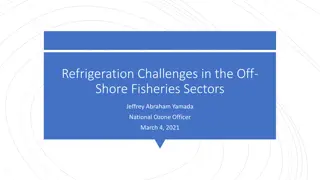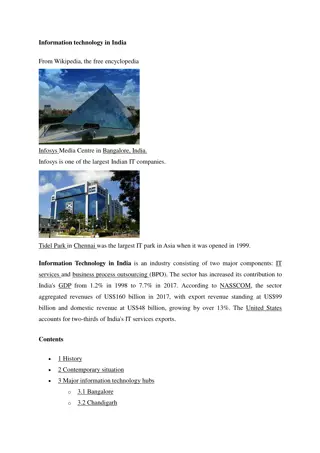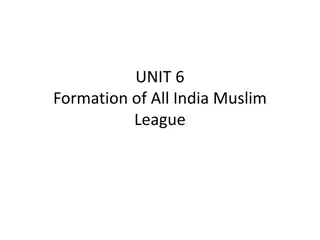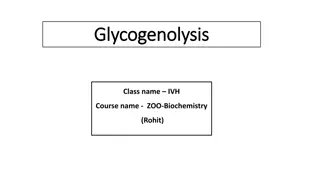Overview of Reservoir Fisheries and Aquaculture in India
Reservoir fisheries play a vital role in India's aquaculture sector, with over 19,000 reservoirs covering millions of hectares. These manmade impoundments serve various purposes like irrigation and power generation. The reservoirs are classified into small, medium, and large categories based on their sizes. Indian reservoirs exhibit diverse limnological profiles, influencing nutrient availability and thermal stratification. Notable large reservoirs in India include Maharana Pratap Sagar and Nagarjuna Sagar.
Download Presentation

Please find below an Image/Link to download the presentation.
The content on the website is provided AS IS for your information and personal use only. It may not be sold, licensed, or shared on other websites without obtaining consent from the author. Download presentation by click this link. If you encounter any issues during the download, it is possible that the publisher has removed the file from their server.
E N D
Presentation Transcript
An Introduction to Reservoir Fisheries Course Title - Aquaculture in Wetlands & Reservoirs (AQC-122) 2(1+1) COURSE INSTRUCTOR Mr. Bhartendu Vimal College of Fisheries, Kishanganj, BASU, Patna
Introduction Reservoir: Manmade impoundment created by obstructing the surfaceflow, by erecting a dam of any description across a river, stream or any water course. A reservoir usually mean a manmade lake created by using a dam or barrage to store water. Reservoirs cover more than 1% of the land surface and created mainly for irrigation, power generationetc. There are 19370 reservoirs in India covering an area of more than 3 million hectares.
Classification There are three types of reservoirs Small Medium Large SMALLRESERVIORS These reservoirs have an area of less than 1000 hectares. There no. in country is19134, covering an area of 1.48 million hectares. Tamil nadu has highest area and no. of small reservoirs with 8895 units followed Karnataka & Andhrapradesh.
Medium Reservoirs Area between 1000 5000hectares. 180 units in country, covering an area of 0.507 millionha. Madhya pradesh has highest area of these reservoirs but Andhra pradesh has highest no. of medium reservoirs 32
Large Reservoirs Area beyond 5000 ha. 56 in number covering an area of 1.60 millionha. Karnataka has max. no. 12 but Andhra pradesh has max. area of these reservoirs
Large Reservoirs in India Maharana Pratap Sagar Himachal Pradesh Stanley Reservoir Tamil Nadu Shanti Sagara Karnataka Minimata Hasdeo Bango Chhattisgarh Nagarjuna Sagar Andhra Pradesh Srisailam Andhra Pradesh Somasila Andhra Pradesh Gobind Sagar Himachal Pradesh
Limnological Profiles of Indian Reservoirs Nutrient rich Peninsular reservoirs have narrow range of air and water temp. fluctuations during dif. Seasons. A phenomenon which prevents thermal stratification. Reservoirs in upper peninsula undergo stratification during summer, but wind induces availability of nutrients at trophogenic zone. Reservoirs of Western Ghats and Northeast are oligotrophic due to poor nutrient status of catchment soil. turbulence facilitating the
Biotic Community of Reservoirs Heavy vegetation. discharge retards the growth of macrophytic Rich plankton community is the hall mark of Indian reservoirs Blue-green algae form main stage of plankton community. Overwhelming aeruginosa in Indian reservoirs is remarkable. presence of cyanobacteria Microcystis
Continued Rocky bottom and water level fluctuations adversely affect benthic community. Icthyofauna of reservoir represent the fauna of parent river system. At the time of impoundment fish diversity suffer a setback as lotichabitat transfers into lentic. Manyspeciesperish and afewadopt to changed situation.
Continued However Indian reservoirs have rich variety of fish species. Large reservoirs harbor 60 species of fishes. Common fish species are :- IMCs: Labeo Rohita, L. calbasu, L. fimbriatus, C. mrigala, Catlacatla Mahseers: Tortor, T. putitora, T. khudree, Neolissochilushexagonolepis Minor carps: Cirrhinuscirrhosa, C. reba, Labeo kontius, L. bata, Puntius sarana, Schizothoraxrichardsonii Catfishes: Aorichthyssheengala, Wallago attu, Pangasiusetc. Featherbacks: Notopterusnotopterus, Notopteruschitala Murrels: Channamarulius, C. stratus, C. punctatus, C.gachua etc. Exotic fishes: Oreochromusmossumbicus, Hypophthalmicthysmolitrix, Cyprinus carpiovar . communis, C. specularis, Gambusia affins, Ctenopharyngodonidella.
Impact of Reservoir Formation on the Native Ichthyofauna Formation of reservoirs have affected especially the following Indigenous fish stocks: The mahseers, snow trouts and Labeo deroand L dyocheilusof the Himalayan streams. The anadromous T. ilisha, the catadromous Eels and Freshwater prawnsof all the major river systems. P . sarana, T. tor, Tor mahanadicus, T. mosal, L.fimbrtatus, L.calbasu,and Rhinomugil corsulaof the Mahanadi river. P .dobsoni,P .dubius,P .carnaticus,and Labeokontiusof the Cauvery basin. P .kolus,P .dubius,P .sarana,P .porcellus,L.fimbrtatus,L. calbasu,L. pangusiaand Torkhudreeof the Krishna riversystem,and The mahseers, eelsand Osteobramabelangiriof the northeast
Determinants of Productivity The factors determining the productivity of reservoirs are classified into :- A. Morphometric factors B. Climatic factors C. Edaphicfactors A. Morphometric factors a) Depth :- Shallow lakes are more productive. b) Shore development :- Higher the degree of irregularity in the shore, higher is the production. c) Fluctuation in water level:- All the biotic communities are at their lowest ebb during max. level fluctuation.
B. Climatic factors Latitude is the most imp. Factor which plays an imp. role In determining the magnitude of solar energy and air temp. In south India fluctuation in air and water temperature is narrowwhich prevents formation of thermocline. During thermal stratification nutrients get locked up at the bottom. When stratification occurs its early breaking is necessary for good production Wind induces turbulence during monsoon usually breaks thermocline in Indian reservoirs.
Continued The rainfall at catchment area is also very imp. than rainfall at reservoir because soil status of catchment area defines the nutrient status of reservoir. Thus in many reservoirs inspite of poor soilquality of basin the productivity is high by virtue of Alloichthonous nutrients.
C. Edaphic factors Physiochemical properties of soil and water are the major determinants of productivity of reservoir. Poor light penetration due to suspended silt and clay retards production but poor visibility due to plankton bloom is +ve index of production. D.O > 5 ppm Ph < 8 ppm Indicators of better production Alkalinity > 50 ppm Hardness > 70 ppm
Formation Areservoir passes through three distinct phases after its formationviz. I. Initial high fertility phase II. Trophic depression phase III. Final fertility phase I. Initial high fertility phase A newly formed reservoir floods vast area , causing decay of submerged vegetation. Nutrients release, causing Initial high fertility phase. Fish food organisms develop. (plankton, bottom microflora and fauna.) Lasts for 2-3 years.
II. Trophic depression phase Characterized by rapid utilization of nutrients by flora and release of nutrients from reservoir bed due tosedimentation. Low production of fish food organisms & low fishgrowth. This stage exists for shorterduration.
III. Final fertility phase A reservoir gradually recovers with accumulation of nutrients. It lasts for 1-1.5years. In Indian reservoirs this phase would be much higher in magnitude than initial and reservoir production increasesafter ageing.
Trophic Dynamics The aquatic ecosystem consists of :- producers autotrophs Primary consumers zooplankton & some fishes. Secondary consumers insect larvae, fishesetc. Tertiary consumers large predators or top carnivores. Decomposers bacteria, fungi. During energy transformation the efficiency of energy conversion is reduced to a tenth from one trophic level to another.
Energy Flow Energy flow and nutrient cycle are two important principlesof ecosystem. Productivity of a lake depends on capacity to transform solarenergy into chemical energy. The studies conducted in Bhavanisagar, Nagarjunsagar, Rihand and Gobindsagar reservoirs have shown that photosynthetic efficiency was high in productive reservoirs like Bhavanisagar (0.412), Nagarjunsagar (0.290) and Gobindsagar (0.692). But it is interesting to note that energy harvest as fish was much low in Nagarjunsagar (0.055) as compared to Bhavanisagar (0.290), which showed that management failed to harvest fish from Nagarjunsagar though it wasproductive.
Continued In an ecosystem the biological output or production of harvestable organisms can be at various trophiclevels. Under a grazing food chain :- Phytoplankton > zooplankton > minnows > catfishes. (or) Phytoplankton > zooplankton > fish system prevails. Shortening the food chain will lead to higher rates of fish production. But in reservoir management there is little scope for changing community structure of plankton to increase production. However alteration in species spectrum of fish may be done and for this only stocking of fish is a successful tool in management.
Fish production trends andpotential Fish yield from Indian reservoirs is poor varying from 0.05 kg/ha in Bihar to 35.5 kg/ha in himachal pradesh with national average of 20 kg/ha. The average national yield from small reservoirs is 50 kg/ha which is well below the rates achieved in China as 800 kg/ha, 300 kg/ha in Srilanka & 100 kg/ha in Cuba.
Present productio n (tonnes) Potential productio n (tonnes) Area (ha) Small 1485557 74200 743000 Medium 507295 6500 127000 Large 1160511 13000 116000 Total 3153366 93700 986000 Actual and potential production from categories of reservoirs in India
Continued There are 19370 reservoirs in country with average production rateof 50 kg/ha, 12kg/ha, 11kg/ha from small, medium and large reservoirs against the potential of 500, 250 and 100kg/harespectively. Present production from all reservoirs in country is 93700tonnes against the potential of 1 milliontonnes.
years Production (t) years Production (t) years Production (t) 1960-61 417 1966-67 291 1972-73 276 1961-62 358 1967-68 357 1973-74 555 1962-63 431 1968-69 354 1974-75 321 1963-64 408 1969-70 230 1975-76 304 1964-65 223 1970-71 260 1976-77 533 1965-66 311 1971-72 254 YEARLY TOTAL LANDINGS FORTHE PERIOD 1960-1961 TO 1976-1977


